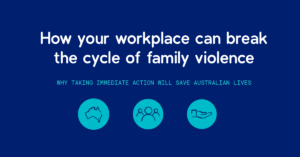Family Violence Doesn’t Discriminate, it Intersects

Exploring the intersections of family violence with three vulnerable groups
Renae Lowry, Executive General Manager, MatchWorks
When I speak to people about family violence, I immediately remind them that it’s not like what you see on the media. It’s also not an issue that’s “out there”, it’s happening all over Australia and it doesn’t discriminate, it intersects.
The first article in this series, Family Violence in Australia Needs Your Attention, focuses on the necessity for workplaces to take action on this issue. I also focus on what family violence looks like in Australia today because, as domestic violence expert, Abby Newman, says, “When you think about the word violence you think physical violence, but a lot of survivors say, ‘I wish he’d just hit me.’ Because being voiceless, not having choice, and not having the ability to be who you are is probably one of the worst experiences of violence” (2019).
This leads us here, to article two, where I discuss the intersections of violence with a focus on three vulnerable groups. It’s the voicelessness that Newman speaks of which features heavily, as well as the severity of control and the additional barriers to reporting that these people may be experiencing.
Again, change is possible and beginning with a foundation of knowledge is essential. From there, you can bring this education to your workplace and change the conversations around family violence.
Culturally and linguistically diverse backgrounds
The facts: Australia is one of the most multicultural countries in the world, where approximately one third of Australia’s population is born overseas (Murdolo & Quiazon 2016). This means that your workplace is likely to be a dynamic and diverse space. So, when looking to change the cycle of family and domestic violence from within your workplace, one approach is simply not enough.
Australia is one of the most multicultural countries in the world, where approximately one third of Australia’s population is born overseas (Murdolo & Quiazon 2016). This means that your workplace is likely to be a dynamic and diverse space. So, when looking to change the cycle of family and domestic violence from within your workplace, one approach is simply not enough.
Newman says that on top of immigration, visas, residency status, and language barriers; their cultural understanding of family violence from their home country can be vastly different. Then there’s the fear of speaking out, especially to police and justice services.
Women experience violence differently depending on their circumstances … women marginalised by age, culture, ethnicity, sexual identity and visa status are more vulnerable to violence and are less likely to have the resources to report it” (Murdolo & Quiazon 2016, pp. 9-11)
What can you do?
When culture and language differ, there can often be gaps in communication. Conversations around privilege and power may not resonate with immigrant and refugee men and women, especially if communicated by Anglo-Australian men or women. It’s important to acknowledge and understand that the person delivering the message is just as important as the message itself.
For culturally and linguistically diverse families, there are additional barriers and vulnerabilities that need to be considered. The way that men from immigrant and refugee communities understand gender equality and the idea of social and cultural change can differ compared to Australian born men. By tackling these issues with varied groups of men, they can then play an important part in challenging the ideas of maculinity and family violence in the workplace.
Indigenous and Torres Strait Islander Australians
Here are the stats: Compared to national statistics, Aboriginal and Torres Strait Islander cultures are 3.1 times more likely to experience family violence, 32 times more likely to be hospitalised, and 11 times more likely to die as a result of family violence (Our Watch 2018). It’s clear how much the issue differs when faced within these groups.
“Violence against women is not an Aboriginal and Torres Strait Islander problem. Nor should Aboriginal and Torres Strait Islander people bear sole responsibility for addressing it. It is an Australian problem, and it is perpetrated by men of all cultural backgrounds” (Our Watch 2015).
What can you do?
In order to prevent violence and break these cycles in Indigenous cultures and communities, work needs to be done to recognise the ongoing impacts of colonisation, heal the impacts of intergenerational trauma, and strengthen culture and identity.
By ensuring that your workplace is free of any discriminatory policies and practices, you’re making a huge difference to the inclusivity of the workplace and the prevention of family violence. While not everyone has the chance to change policies, everyone can challenge gender stereotypes and racism in the workplace. Empowering those vulnerable people in your workplace can lead to positive action and changes. How? Start by supporting the Indigenous women in your organisation into leadership and decision-making roles, and call people out when their language is adding to gender and race discrimination.
People with disability
What you need to know: Women with disability are one of the most vulnerable groups in our society. As well as experiencing daily challenges both at home and in the workplace, they can also find themselves impacted by family violence. We mentioned earlier that family violence is not always expressed in physical violence and this is especially true for people with disability. Here are some of the ways that family violence can be expressed in this intersection:
- Neglect
- Withholding medication and assistive devices
- Restricting the use of communication aids
- Restricting financial access
- Refusal of caregivers to assist with bathing or eating
- Verbal abuse
- Physical abuse
What can you do?
Unfortunately for some people living with disability, their communication may be restricted which makes it harder to identify if they’re experiencing violence. While not all people with disability struggle with communication, they can still find it increasingly hard to speak out. This is especially true if their abuser is also acting in a caregiver role. The person may need someone to speak on their behalf and advocate for their safety. By working with disability organisations, your workplace can learn how to identify what signs to look out for and how best to act on them. Remember, understanding what to look out for can prepare you to be better equipped to act on behalf of a person with disability, and to help break the cycle of family violence.
Violence doesn’t discriminate, it intersects
If I leave you with anything, it’s that it is essential to understand intersectional experiences to drive change from within your workplace.
From this point of knowledge, the final article in this series will outline actions and strategies that you can begin to implement in your workplace today. Covering education, empowerment, safety, and belonging; you can save lives and change the current trajectory of family violence in Australia.

References
Murdolo, A & Quiazon, R 2016, Key issues in working with men from immigrant and refugee communities in preventing violence against women. White Ribbon Australia.
Newman, A 2019, Interview with Sophy Chirnside from MatchWorks, 2 August.
Our Watch, Australia’s National Research Organisation for Women’s Safety (ANROWS) and VicHealth 2015, Change the story: A shared framework for the primary prevention of violence against women and their children in Australia, Our Watch, Melbourne, Australia.